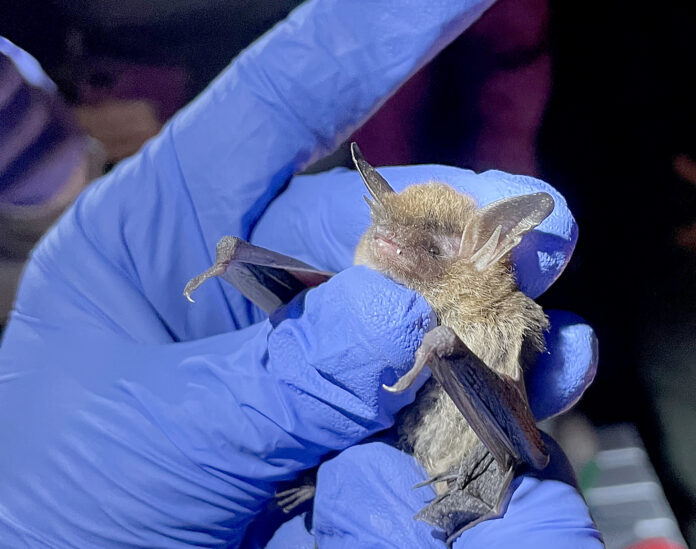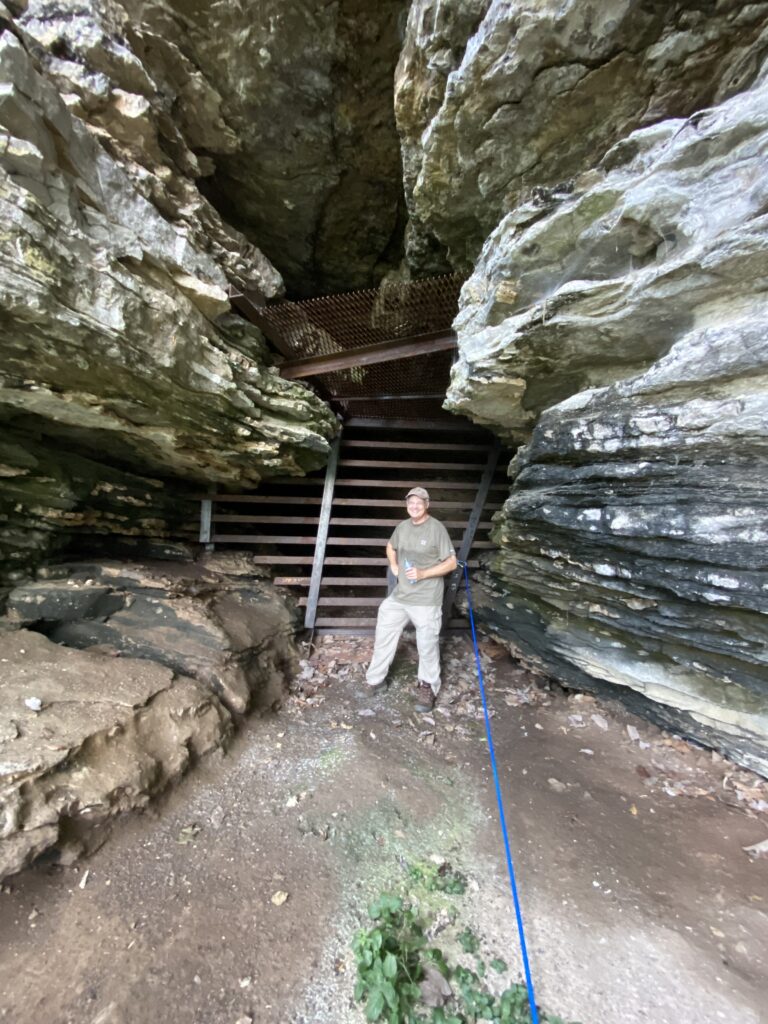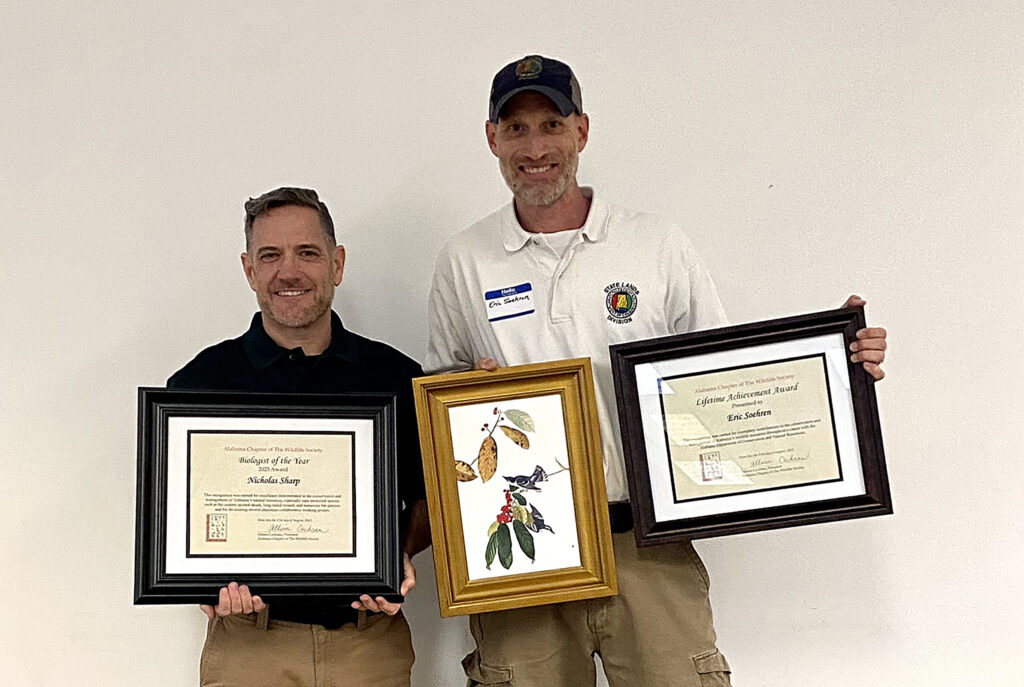
MONTGOMERY, Ala. – Bats are ubiquitous during the Halloween season, but these creatures deserve celebration year-round for their contribution to our sustainable food production. By eating insects by the billions, bats save U.S. agriculture as much as $3.7 billion per year in pest control. Bats also play a role in the pollination of some plants.
After Bat Week ended on Halloween, the celebration at the Alabama Department of Conservation and Natural Resources’ (ADCNR) Wildlife and Freshwater Fisheries (WFF) Division continued with the recognition of one of its biologists, Nick Sharp, for his contributions to bat research and protection in Alabama. As chair of the Alabama Bat Working Group, Sharp recently accepted the Alabama Wildlife Federation’s (AWF) Governor’s Conservation Achievement Award for Wildlife Conservationist of the Year. Sharp was also recognized individually by the Alabama Chapter of the Wildlife Society as Wildlife Biologist of the Year.
“It was extremely important to be recognized,” Amy Silvano, WFF’s Assistant Chief of the Wildlife Section. said of the AWF and Wildlife Society awards. “The Alabama Bat Working Group is a collaborative conservation effort composed of multiple agencies. These organizations and individuals collectively work toward the conservation of bats and their habitat throughout the state. The group has identified bat management practices, workshop training and they host the Bat Blitz.”
During this year’s Bat Blitz in May in southwest Alabama, the group captured a bat species, the northern long-eared bat, that was thought to have almost disappeared from the state because of white-nose syndrome (WNS), a deadly fungal disease that infects hibernating bats. On the last day of the event, one male and two pregnant female northern long-eared bats were captured, identified and later released on a Forever Wild Land Trust tract within the Perdido River Wildlife Management Area (WMA) in Baldwin County.
“The Department of Conservation and Natural Resources has been intentional about acquiring land along the Perdido River corridor to add to the land that currently encompasses the Perdido WMA,” said ADCNR Commissioner Chris Blankenship, who serves as Chairman of the Forever Wild Land Trust Board of Trustees. “The discovery of this endangered species in the area we are working to protect is further evidence of the importance of this land in eastern Baldwin County.”
Although the awards were greatly appreciated, the discovery of the northern long-eared bat was the most important event of 2023 for Sharp.
“Those captures of the northern long-eared bat caused a great deal of excitement,” Sharp said. “None of us expected to catch them. For background on this, in the past few years, they have discovered populations of northern long-eared bats in coastal North Carolina and South Carolina. The reason that’s important is there are no caves in those areas. They also determined these bats were active year-round, that they weren’t going into hibernation. So, that’s important because it means they are not going into caves and being exposed to white-nose syndrome.”
Sharp said this species was one of the most common species in eastern North America. Because the population has been decimated by WNS, the northern long-eared bat was federally listed as endangered under the Endangered Species Act in 2022.
“The fact that these bats were living in these areas and not dying of white-nose syndrome created this idea that we should organize the Bat Blitz to go to coastal Alabama,” he said. “We thought it was a longshot, but we decided to try. Lo and behold, on the last night of the Bat Blitz, we made those captures. It was surprising and quite rewarding – taking a longshot effort and it is paying off. This has really good implications for this species in Alabama because there are no caves in coastal Alabama.”

Keith Hudson, a biologist with the Alabama Bat Working Group, stands in front of the completed gate at Bat Cave outside Florence. WFF photo
Biologists returned to Perdido River WMA in June of this year to try to catch additional northern long-eared bats. Another male and a lactating female were captured, indicating the female had given birth in the area.
Sharp said although an attempt to track the bats with radio tags was unsuccessful, the ability to return to the site and catch more northern long-eared bats confirms a resident, breeding population in the area.
“Coastal Alabama can be added to the list of locations where these bats may survive white-nose syndrome,” Sharp said. “That’s quite important for Alabama and the whole bat world.”
Another bat species that was once common but is now of concern is the tri-colored bat. A total of 15 bat species have been documented in Alabama.
“The tri-colored bat used to be so numerous in caves that nobody bothered to count them,” Sharp said. “But now they have been heavily affected by white-nose syndrome, so now they are under review for listing under the Endangered Species Act. We anticipate that decision to come in the coming year.”
Sharp said, fortunately, the status of WNS in Alabama has changed very little since 2017. WNS has not been detected in south Alabama, so it appears the disease hasn’t spread any farther south.
“It’s still a significant threat,” he said. “White-nose syndrome continues to be a devastating disease. Despite a lot of effort, no cure or treatment has been developed. In the last couple of years, tri-colored bat numbers have looked a little more stable. Maybe they are leveling out although we don’t have the numbers we used to have.”
As far as conservation efforts, another cave, this one called Bat Cave in Lauderdale County near Florence, has been gated to protect the bats’ habitat from human disturbance.
“The area along the Tennessee River is very important for gray bats, another endangered species,” Sharp said. “That species seems to be doing okay. The habitat in Alabama is very important to them, so being able to put the gate on that cave is another important step in the conservation of that species.”
As for the awards, Sharp said the AWF award was special, but the recognition should include all members of the working group.
“The Alabama Bat Working Group is a collection of people from state, federal and private entities,” he said. “I received the award on behalf of the working group as its leader for the last eight years. I received the award, but it was not just me. It was the whole working group. It never crossed my mind that I would receive an award for the group.
“Likewise, it never crossed my mind that I would receive an award from the Alabama Chapter of the Wildlife Society. It really represents the pinnacle of my career. It’s very gratifying that both of these awards are nominations from my peers. I can’t ask for more than that.”
Silvano said Sharp’s efforts have been crucial to the conservation of numerous species in Alabama.
“Nick has been one of the pivotal members in our agency for threatened and endangered species, especially bats,” Silvano said. “He, with multiple partners, has identified multiple wintering caves that we have gotten grant funds for to gate and protect. That has really been spearheaded by Nick. He has done a wonderful job in his collaborative efforts.”

WFF’s Nick Sharp, left, was named Biologist of the Year and Eric Soehren received the Lifetime Achievement award from the Alabama Chapter of the Wildlife Society. WFF photo



























